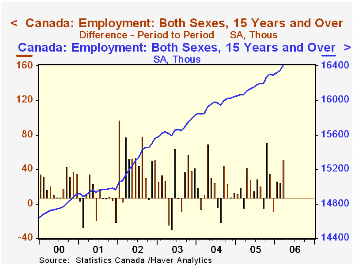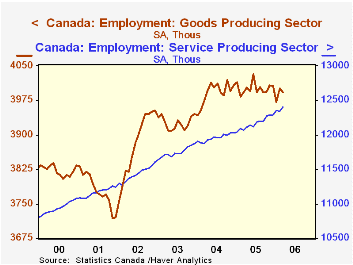 Global| Apr 07 2006
Global| Apr 07 2006Canadian Unemployment Hits 31-Year Low in March; Employers Add 50,000 New Workers
Summary
The unemployment rate in Canada eased 0.1% in March to 6.3%, the lowest level since December 1974. Statistics Canada further reported that 50,500 more people had jobs in March, following on rises of 24,700 in February and 26,300 in [...]

The unemployment rate in Canada eased 0.1% in March to 6.3%, the lowest level since December 1974. Statistics Canada further reported that 50,500 more people had jobs in March, following on rises of 24,700 in February and 26,300 in January. Over the last year, employment has expanded 2.1%, the strongest 12-month increase since May 2004, and as we pointed out yesterday, this compares very favorably with employment gains in most other large industrial countries.
The fall in unemployment was all the more notable as it accompanied a rise in the labor force participation rate, the proportion of the population who have jobs or want them. It picked up from 67.0% in February to 67.2% in March. This ratio had been drifting downward, as people were pulling back from the labor force. But it has been basically flat for about a year now, so that recent declines in unemployment reflect genuine economic improvement, not discouraged workers.
The employment growth is occurring in the service industries, as seen in the table below. Business services, transport & warehousing, heath care and information, culture & recreation are the sectors with the largest gains in March. At the same time, the goods-producing industries have widely divergent patterns. As in many Western countries, manufacturing jobs are declining fairly consistently, and in Canada, so are those at utilities. But construction and mining (including gas and oil production) are both on quite distinct uptrends. While the mining gains are easily explained by high oil prices, we are struck by the long run-up in construction employment. It began growing in 1998 and appears to parallel expansion in residential and civil-engineering projects.
Despite this "good news" on employment and unemployment, Canadian financial markets reacted negatively. They see these favorable economic factors as contributing to interest rate increases, so by Friday noon, the TSE had lost 121 points, right at 1% of its value and 10-year Canadian bond yields added 5 basis points. US markets were responding to the US data in similar fashion. Both currencies, though, were rising, and versus the euro, the Canadian dollar was increasing more than the US dollar. Check DAILY and INTDAILY at the end of the business day today to see how these financial responses evolved over the day as a whole.
| Canada (Seasonally Adjusted) |
Mar 2006 | Feb 2006 | Jan 2006 | Year Ago | 2005 | 2004 | 2003 |
|---|---|---|---|---|---|---|---|
| Unemployment Rate (%) | 6.3 | 6.4 | 6.6 | 6.9 | 6.8 | 7.2 | 7.6 |
| Participation Rate (%) | 67.2 | 67.0 | 67.2 | 67.2 | 67.2 | 67.5 | 67.5 |
| Employment (Change, 000s/%) |
+50.5 | +24.7 | +26.3 | 2.1% | 1.4% | 1.8% | 2.4% |
| Goods-Producing | -9.5 | 30.5 | -34.4 | -0.0% | 0.2% | 1.7% | 1.2% |
| Service-Producing | +60.0 | -5.8 | 60.7 | 2.7% | 1.8% | 1.8% | 2.7% |
Carol Stone, CBE
AuthorMore in Author Profile »Carol Stone, CBE came to Haver Analytics in 2003 following more than 35 years as a financial market economist at major Wall Street financial institutions, most especially Merrill Lynch and Nomura Securities. She had broad experience in analysis and forecasting of flow-of-funds accounts, the federal budget and Federal Reserve operations. At Nomura Securities, among other duties, she developed various indicator forecasting tools and edited a daily global publication produced in London and New York for readers in Tokyo. At Haver Analytics, Carol was a member of the Research Department, aiding database managers with research and documentation efforts, as well as posting commentary on select economic reports. In addition, she conducted Ways-of-the-World, a blog on economic issues for an Episcopal-Church-affiliated website, The Geranium Farm. During her career, Carol served as an officer of the Money Marketeers and the Downtown Economists Club. She had a PhD from NYU's Stern School of Business. She lived in Brooklyn, New York, and had a weekend home on Long Island.





